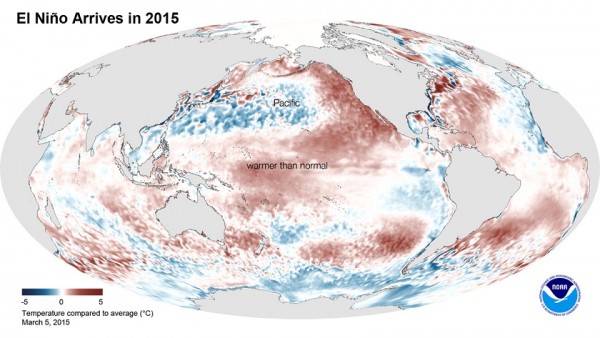El Nino Boosts Carbon Dioxide Levels in Atmosphere to Alarming Highest Records
| Ana Verayo | | Jun 14, 2016 05:15 AM EDT |
(Photo : NOAA) This image shows the average sea surface temperature for February 2015 as measured by NOAA satellites. The large area of red (warmer than average) can be seen extending through the equatorial Pacific.
Scientists say that carbon dioxide levels in the atmosphere will now reach above threshold levels for the first time in 2016.
More specifically, concentrations of these greenhous gas emissions will exceed 400 parts per million for the entire year, as record annual carbon dioxide levels will aparently be affected by a natural powerful climate event known as El Nino that can shift global temperatures and weather.
Like Us on Facebook
El Nino's impacts will include drier conditions in the tropical regions where it reduces the carbon uptake and triggers more forest fires that can release gas which can boost carbon dioxide levels even more, already adding to burning fossil fuels by man made activities.
According to lead author of the study, Richard Betts of the Met Office Hadley Center and the University of Exeter, this atmospheric carbon dioxide concentration is rising every year due to increasing man made carbon emissions however, this year's highest concentrations are further boosted by the El Nino event.
Carbon dioxide in the Earth's atmosphere will reach a record of 3.15 ppm between 2015 to 2016 which is an alarming rate, at above average increasing to 2.1 ppm per year, in the last 60 years, according to researchers' forecast.
In 2015, the annual average carbon dioxide concentrations in the atmosphere surpassed the 400 ppm threshold where this year's will be the first to maintain above level for the entire year and most likely even in our entire lifetimes, according to scientists.
These figures are based from the carbon dioxide record obtained from Mauna Loa, Hawaii in the United States that were first monitored by Charles David Keeling in 1958, where the first measurements only registered 315 ppm in the planet's atmosphere.
This new study is published in the journal Nature Climate Change.
TagsEl Nino, carbon dioxide levels atmosphere, Climate Change, record levels carbon dioxide, Carbon emissions, man made carbon emissions, el nino carbon dioxide levels
©2015 Chinatopix All rights reserved. Do not reproduce without permission
EDITOR'S PICKS
-

Did the Trump administration just announce plans for a trade war with ‘hostile’ China and Russia?
-

US Senate passes Taiwan travel bill slammed by China
-

As Yan Sihong’s family grieves, here are other Chinese students who went missing abroad. Some have never been found
-

Beijing blasts Western critics who ‘smear China’ with the term sharp power
-

China Envoy Seeks to Defuse Tensions With U.S. as a Trade War Brews
-

Singapore's Deputy PM Provides Bitcoin Vote of Confidence Amid China's Blanket Bans
-

China warns investors over risks in overseas virtual currency trading
-

Chinese government most trustworthy: survey
-

Kashima Antlers On Course For Back-To-Back Titles
MOST POPULAR
LATEST NEWS
Zhou Yongkang: China's Former Security Chief Sentenced to Life in Prison

China's former Chief of the Ministry of Public Security, Zhou Yongkang, has been given a life sentence after he was found guilty of abusing his office, bribery and deliberately ... Full Article
TRENDING STORY

China Pork Prices Expected to Stabilize As The Supplies Recover

Elephone P9000 Smartphone is now on Sale on Amazon India

There's a Big Chance Cliffhangers Won't Still Be Resolved When Grey's Anatomy Season 13 Returns

Supreme Court Ruled on Samsung vs Apple Dispute for Patent Infringement

Microsoft Surface Pro 5 Rumors and Release Date: What is the Latest?










